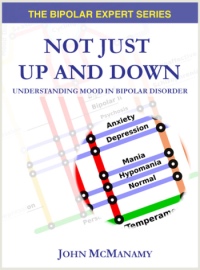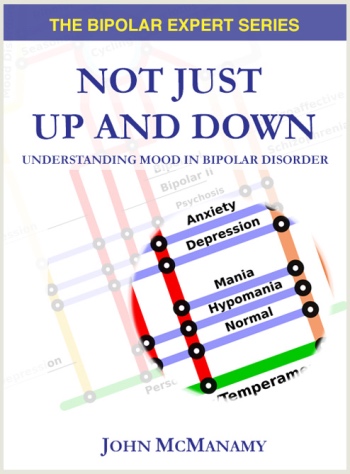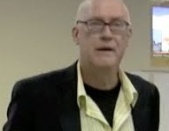The True Meaning of Manic-Depression
 |
It actually means something different than bipolar disorder.
|
Mood Spectrum. In 1990, Oxford University Press published Goodwin and Jamison’s classic "Manic-Depressive Illness." The 900-page text was quickly recognized as the definitive work on the topic, and earned its authors universal gratitude and acclaim.
The long-awaited second edition hit the streets in 2007 and is well worth the wait. At more than 1,200 pages and with an impressive list of collaborators shedding light on all manner of matters melancholic and manic, the book represents a virtual Manhattan Project on mood disorders.
My New Book!

Purchase now.
The crucial distinction is that while the object of the Manhattan Project was to initiate a nuclear chain reaction, you can say that the goal of "Manic-Depressive Illness" is to put one out.
But Manhattan Projects with densely-packed polysyllables are hardly the type of beach read that patients will be pulling out of their tote bags, along with their Snapple and sun block. With tongue-twisters such as "endogenous" and "etiological" appearing in the same sentence, this is clearly a text for clinicians.
But don’t let clinician-speak intimidate you. The authors went to great lengths to organize their subject matter into a meaningful and comprehensive whole, with clear transitions from one topic to the next. A few pages into the text, and one quickly becomes habituated to the polysyllables. Then it’s clear sailing.
The Authors and Their Collaborators
Frederick Goodwin MD is the former head of the NIMH and professor of psychiatry at George Washington University. His accomplishments are far too numerous to do justice here. Suffice to say, a lot of what we take for granted today on diagnostic and treatment issues we owe to Dr Goodwin. To use bipolar II as one example, Dr Goodwin and his collaborators from the seventies practically own the topic.
Kay Jamison PhD is professor of psychiatry at Johns Hopkins. Her public declaration of her illness, published as a memoir in an "Unquiet Mind," has endeared her throughout the bipolar community. Her other popular works such as "Touched with Fire" have earned her plaudits as a literary author of the first rank, as well as for being a top researcher.
For this edition, Drs Goodwin and Jamison enlisted a brain trust of 15 collaborators. The primary collaborators include: S Nassir Ghaemi MD of Emory University; Constance Hamen PhD of UCLA; Terrence Ketter MD of Stanford; Husseini Manji MD of the NIMH; Francis Mondimore MD of Johns Hopkins; James Potash MD of Johns Hopkins; Harold Sackeim PhD of Columbia University; and Myrna Weissman PhD of Columbia University.
Also included are: Hagop Akiskal MD of the University of California San Diego; Gabrielle Carlson MD of SUNY; J Raymond DePaulo MD of Johns Hopkins; Ian Fawcett MD of the University of New Mexico; Daniel Lieberman MD of George Washington University; Miriam Davis PhD of George Washington University, and Teodore Postolache MD of the University of Maryland.
But the buck stops with the two principal authors. As Dr Goodwin was at pains to point out at a book launch in Chevy Chase, MD at the end of March, 2007, every collaborator had to be on board with the authors’ over-arching theme of manic-depressive illness embracing both recurrent depression and bipolar disorder (oh, to have been privy to the conversations between Drs Goodwin and Akiskal on this).
It’s All About Kraepelin
The second edition contains a subtitle that was not in the first: "Bipolar Disorders and Recurrent Depression."
As the authors make explicitly clear, the title to the book means precisely what the pioneering German diagnostician Emil Kraepelin meant by the use of the term, "manic-depressive illness," (he used insanity in place of illness) back in the early twentieth century. Kraepelin was born the same year as Freud, but there the semblance ends – for the purposes of this review Kraepelin actually knew what he was talking about.
It was Kraepelin who coined the term, manic-depression, but with this twist: By manic-depression, he did not mean simply a synonym for bipolar disorder. He was also referring to the type of depressions that keep coming back, recurrent depressions as opposed to chronic depression – depressions that seem to cycle, if you like.
Could these recurrent depressions be regarded as part of the same phenomenon that also includes bipolar disorder? Kraepelin thought so, and so do Drs Goodwin and Jamison. Back when psychiatry was weaning itself off of Freud in the sixties and seventies, this was the prevailing view among leading researchers and seemed to be the way the profession was going.
Although Kraepelin saw recurrent depression and bipolar as closely related, this does not mean they are the same illness. Bipolars, after all have a way of cycling into mania, while those who simply cycle in and out of recurrent depression never get too far off the launching pad.
The authors ask us to imagine a broad category called "mood-affective disorders." What they refer to as "recurrent (episodic) affective disorders" is the object of their book, with what equates to what Kraepelin meant by manic-depressive illness.
Recurrent affective disorders, in turn, is subdivided into bipolar (which embraces BP I, BP II, NOS, and cyclothymia), and unipolar (embracing psychotic and non-psychotic).
What the authors call "depressive disorders" – chronic major depression and dysthymia – depressions that don’t seem to go away, depressions that don’t cycle – is a separate phenomenon and does not fall within the scope of the book.
The authors touched on a lot of this in their first edition, but their point was easily lost in the plethora of competing information. Not so this time. If you managed to skim over the Foreword and Introduction without Kraepelin sinking in, you are going to be banged on the head with him in Chapter One, with an encore in Chapter Two.
It’s all about Kraepelin, is the authors’ unambiguous message, with the strong implication that psychiatry has ignored the obvious for way too long. With some 1.2 million on advance sales for "Manic-Depressive Illness," this time the profession may finally get the message.
Setting the Scene
Before Kraepelin, there was Hippocrates. Drs Goodwin and Jamison go way beyond giving us a history lesson, here. Only by developing an appreciation for how some of the best minds over the last 2,500 years chronicled what they saw, the authors contend, can we begin to get a grasp on the phenomenon we call manic-depressive illness.
The term, melancholy, was coined by Hippocrates, and literally means "black bile." The word is virtuously synonymous with our modern conception of depression, though its meaning was rather more broadly applied. Importantly, Hippocrates and his school saw mental illness as biologically-based.
Aristotle was the first observer on record to make a connection between melancholic temperament and being gifted. Significantly, he made his case by citing as examples Socrates and Plato.
The Hippocratic school attributed mania to an excess of yellow bile. Aretaeus of Cappadocia, in the second century AD, appears to have been the first to connect melancholy to mania, observations that were touched on by his near-contemporary, Galen of Pergamon. Thus we see the beginnings of modern debate, regrettably sidetracked by the Dark Ages and Freud, which many view as synonymous.
Essentially, depression and mania were readily observable, but how did they link up, how did they relate? Did either condition reflect a mere aberration in the human psyche, or was something much deeper going on here? State or trait? If someone got depressed, then depressed again, was it two separate depressions, or part of a depression that kept cycling back? Did mania bring on depression? Or vice-versa? Or were they separate entities? And what was the explanation for those weird behaviors that seemed to be a combination of both? And what about those crazy delusional states? Where did they fit in?
The answers were not about to reveal themselves by mere casual observation. Individuals had to be carefully assessed longitudinally, over time.
The first modern diagnosis of "melancholic-manic affect" may have been made in 1759 by Andres Piquer, physician to King Ferdinand VI of Spain. Wrote Piquer: "Melancholy and mania, although treated in many medical books separately, are one and the same illness, and only differ according to the various grades of activity and diversity of affective states that occur in both."
A hundred years later, French physicians were writing about "la folie circular." The empirical evidence was stacking up. A picture was forming, albeit a jigsaw puzzle with the pieces not yet joined.
Enter Kraepelin
Kraepelin published his first edition to "Manic-Depressive Insanity and Paranoia" in 1899 and his last in 1921. His early editions indicate a work-in-progress, but in 1913 we see an elegant and mature classification system. Instead of a host of disconnected conditions, Kraepelin grouped mania and depression under the same umbrella, with a lot of refined splitting.
What Kraepelin did for manic depression, he also achieved much the same thing for schizophrenia. Conceivably, he could have joined what he called dementia praecox to manic-depression, with psychosis as the connecting link, but he differentiated the two on grounds of severity, chronicity, and outcome.
Overnight, psychiatry had a navigation system. Kraepelin’s achievement, the authors point out, was not in correctly describing nature, which is always open to question, but in building a solid base for future work.
Post Kraepelin
A funny thing happened to Kraepelin. In America, he was blind-sided by Freud and his followers and largely forgotten. European psychiatry, however, by and large, still adhered to the disease model, which assumed a biological component. For example, Kraepelin’s disciple, Eugen Bleuler, softened the division between manic-depression and schizophrenia, but contributed insights that anticipated the later unipolar-bipolar distinction.
In 1957, Karl Leonard reported that while some patients had histories of both depression and mania, some had histories of depression only. Notably, he based his conclusions upon more than clinical description, namely family history. In 1966 Jules Angst and Carlo Perris independently came up with the family data to support Leonhard. The idea of a unipolar-bipolar distinction was in play.
Yet another funny thing happened to Kraepelin. In America, he was blind-sided by the arbitrary unipolar-bipolar firewall erected by the DSM-III of 1980. Europe, in turn, would incorporate much of the DSM into its ICD classification system. This unipolar-bipolar dichotomy has been preserved in the DSM-IV of 1994 and will continue with the DSM-5 of 2013.
The authors do not oppose an intelligent separation. Their beef is that the DSM "obscures the fact that originally, the bipolar-unipolar distinction was conceived of as a way to distinguish two forms of a recurrent illness. In other words, the DSM structure gives precedence to polarity over cyclicity, obscuring the reality that one rather common variant of unipolar illness is as recurrent or cyclic as bipolar illness."
In other words, some types of unipolar depression have more in common with bipolar disorder than with other types of unipolar depression.
This is no mere academic hair-splitting. If one’s illness is truly cyclic – be it bipolar or unipolar – we may be talking about different treatment options and management strategies. Perhaps your doctor can eventually figure this out, but can you afford to wait?
Mixing It Up
Many of us have a lot more to our depressions than "just depression" and to our manias than "just mania," and, not surprisingly, as Goodwin and Jamison point out, Kraepelin had a lot to say on this mater. Features of depression and mania have a way of colliding into what are referred to as "mixed states." Think of energized depressions or hellish manias, of mania symptoms in depression and depressive symptoms in mania. Think of irritability, road rage, mental distress. A lot of us spend a good part of our lives in states barely recognized by the DSM.
Kraepelin talked about depressive or anxious mania and excited depression, but Aretaeus turned in his homework some 1,800 years earlier in his observation that those with melancholy "could be angry without reason."
Full-blown mania mixed with full-blown depression (the only mixed state recognized by the DSM) may include perhaps 20 percent of us. But loosen the criteria to say two depressed symptoms in mania or hypomania, or two manic/hypomanic symptoms in depression and we are talking figures that range from one-third to two thirds of our population.
A 1972 study that Dr Goodwin was involved in found "depressive effect" to be pervasive in manic patients. Half of the 20 patients in his study actually had higher depression ratings during their manic phases than while in their non-manic depressed phases.
And you thought mania was all about letting the good times roll. Meanwhile, how many depressed individuals wished that they were only sad?
Again, the treatment and illness-management implications are enormous.
Yet Another Spectrum Twist
Goodwin and Jamison point out that Kraepelin also conceptualized the spectrum as the relationship between mood disorders and temperament. At this stage, we are dealing with far more by way of hypothesis rather than fact, but Goodwin and Jamison’s collaborator, Dr Akiskal, has been hard at work blazing trails.
"Hyperthymic" and "depressive," for example, indicate the soft end of the manic and depressed spectrums, respectively. Think of these as personality "traits" rather than illness "states." We have yet to establish causation between trait and state, which makes for some interesting theorizing. For example, can a discordance between trait and state – say an individual with a hyperthymic personality slipping into depression – account for mixed episodes?
As Goodwin and Jamison are quick to point out – and they apply this to all areas of inquiry into mood disorders – the jury is out until incontrovertible genetic evidence starts rolling in. But they also note that we won’t find the genes unless we know what we’re looking for. To arrive at the answers, we have to ask the right questions – a line of inquiry that began with Hippocrates and continued through to Kraepelin and those who built on his work to today’s new generation of icon-smashers who, oddly enough, cite Kraepelin as their inspiration.
You can almost say that the history of manic-depression builds up to Kraepelin, builds upon Kraepelin, and looks back to Kraepelin. Eventually, we will have to look beyond Kraepelin, but for that to happen, the authors seem to imply, fist we have to get Kraepelin right. No more Freud, no more DSM funny business.
With that in mind, I humbly propose a new title for the third edition, which can never arrive soon enough: "Kraepelin’s Disease."
Let’s give the guy his due.
Did You Know?
Kay Jamison PhD does all her writing in longhand, and has a typist transcribe her manuscript. This was revealed at the authors’ 2007 book launch in Chevy Chase, MD, when Dr Jamison graciously thanked her typist, who was in attendance.
Special Word to Patients
With a list price of $99, sales resistance is understandable, especially for a book intended for clinicians. My two cents: You cannot afford NOT to have this book. Each day you struggle with this illness costs you money, already. The cost-benefit is a no-brainer. Stop paying your cable bill, if you have to, and make what could prove to be the best investment of your life.
See also The Mood Spectrum, Multipolar Depression, and Hard Depression, Soft Bipolar.
May 9, 2007, reviewed Jan 10, 2011
 |
More articles on mood. |




